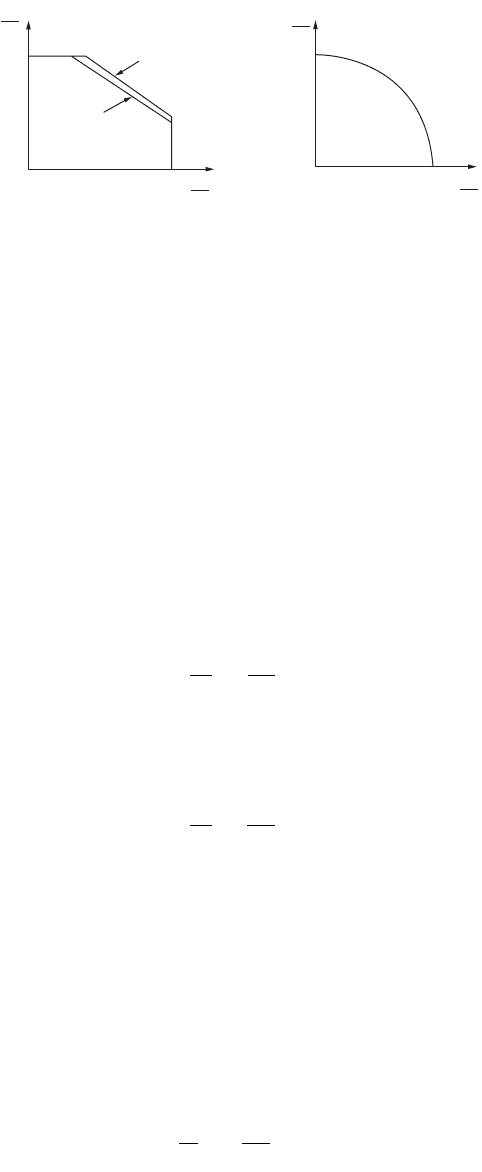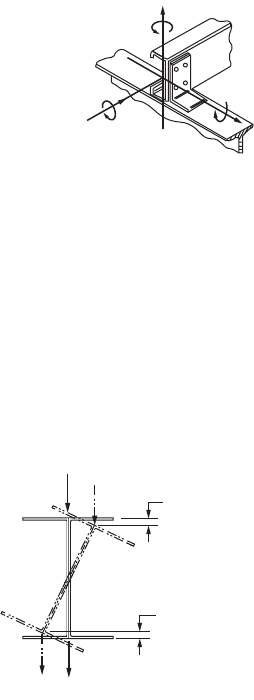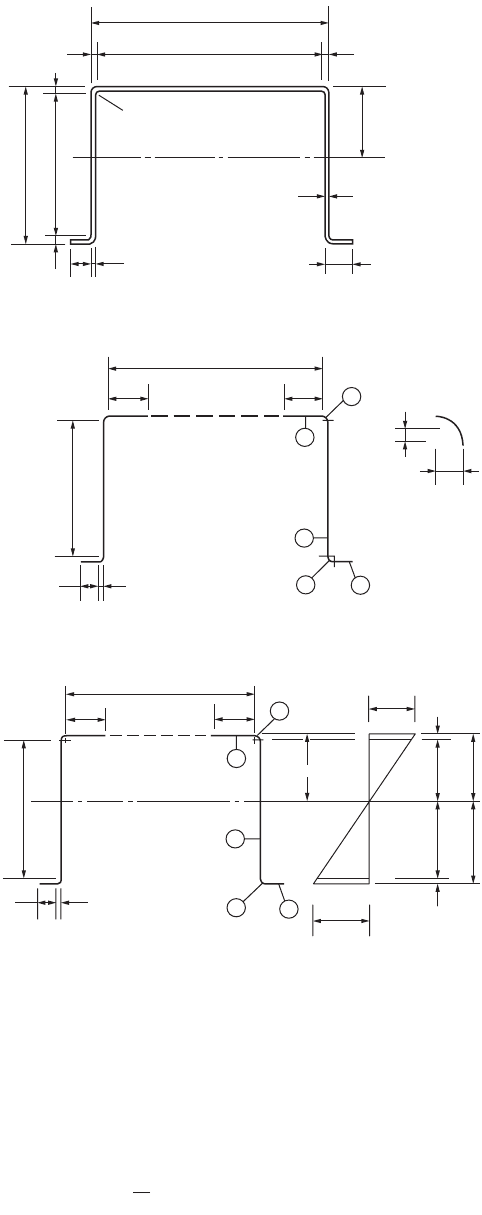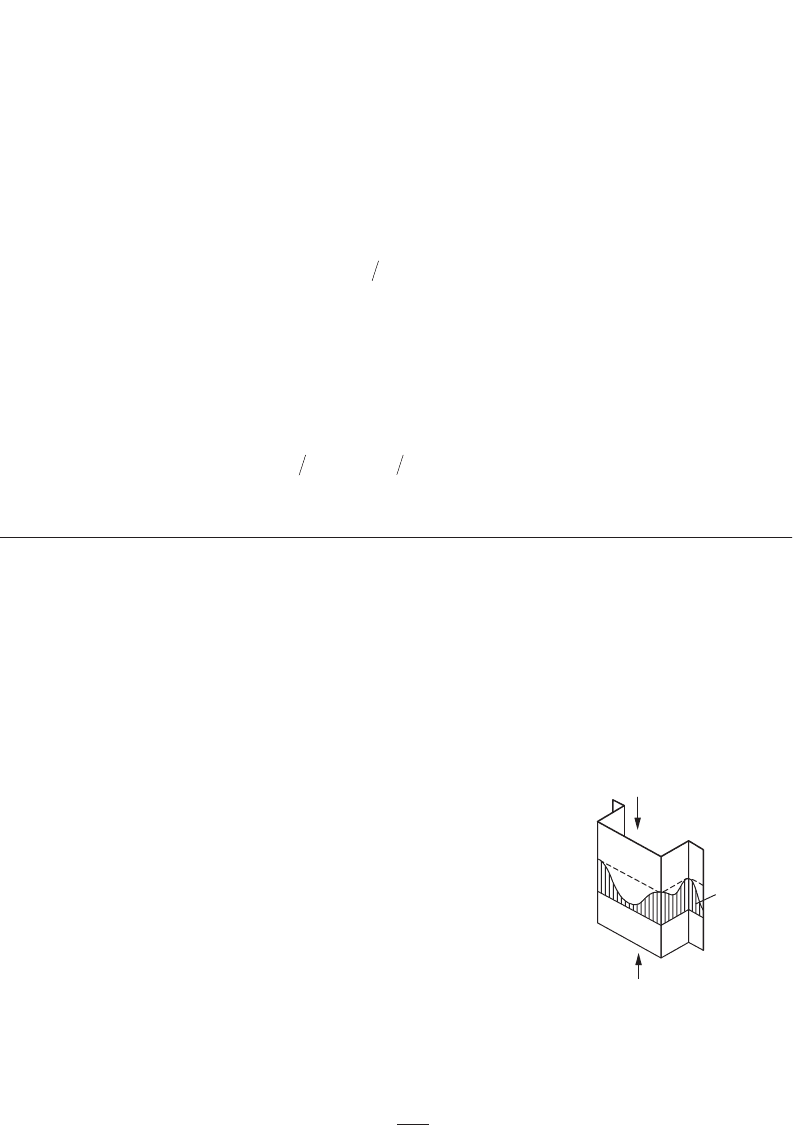Wai-Fah Chen.The Civil Engineering Handbook
Подождите немного. Документ загружается.


49-24 The Civil Engineering Handbook, Second Edition
the capacity of a member subject to a variety of different actions, all actions that contribute to failure
should be incorporated in the assessment. This is rather difficult, however, because of the complexities
of taking many actions into account at the same time, and in practice the main actions are included only
in the interaction equations. Design codes give interaction equations dealing with the combinations of
bending and web crushing and web crushing and shear.
Combined Bending and Web Crushing
Since the web crushing provisions were adapted from the AISI specification, the rules in BS 5950, Part 5,
governing the load capacity of beams under combined bending and web crushing were naturally taken
from the same source. The AISI rules were based on a series of tests carried out at the University of
Missouri–Rolla (Hetrakul and Yu, 1980). Two different interaction formulas are given in BS 5950, Part 5:
one for single-thickness webs and the other for I beams made from channels connected back-to-back.
For single-thickness webs the relevant interaction equation is
(49.24)
For I beams, or for any section where the web is provided with a high degree of rotational restraint
at its junction with the flange, the relevant interaction equation is
(49.25)
In both of these equations F
w
is the concentrated web load or reaction, M is the applied bending
moment at the point of application of the web load, and P
w
and M
c
are the web crushing capacity and
moment capacity, respectively, of the member. These equations are, of course, subject to the overriding
conditions that P cannot be greater than P
w
and M cannot be greater than M
c
. The interaction diagrams
are shown in Fig. 49.26a, which indicates that single-thickness webs are considered to be affected to a
somewhat greater extent by the combination of effects than I-beam webs.
Combined Bending and Shear
The interaction of shear force and bending is covered in BS 5950, Part 5, by the equation
(49.26)
FIGURE 49.26 (a) Interaction diagram for combined web crushing and shear. (b) Interaction diagram for combined
bending and shear.
Single
thickness
webs
1
I Beam
or similar
1
F
w
P
w
F
v
P
v
M
M
c
M
M
c
1.0
1.0
(a) (b)
12 15..
F
P
M
M
w
wc
Ê
Ë
Á
ˆ
¯
˜
+
Ê
Ë
Á
ˆ
¯
˜
£
11 15..
F
P
M
M
w
wc
Ê
Ë
Á
ˆ
¯
˜
+
Ê
Ë
Á
ˆ
¯
˜
=
F
P
M
M
v
vc
Ê
Ë
Á
ˆ
¯
˜
+
Ê
Ë
Á
ˆ
¯
˜
£
22
1
© 2003 by CRC Press LLC

Cold Formed Steel Structures 49-25
where F
v
and P
v
are the shear force and shear capacity, respectively. This equation is illustrated in
Fig. 49.26b and is the same as that used in the AISI specification. The AISI specification also has further
provisions for webs fitted with transverse stiffeners at the load points.
Lateral Buckling
Lateral buckling, sometimes called lateral torsional buckling, generally occurs when a beam that is bent
about its major axis develops a tendency to displace laterally, i.e., perpendicularly to the direction of
loading, and twist. Many, if not most, beams used in cold-formed construction are restrained against
lateral movement, in many cases continuously restrained by roof or wall cladding. In other cases restraint
is afforded by other members connected to the beam in question or by bracing such as antisag bars. Such
restraints reduce the potentiality of lateral buckling, but do not necessarily eliminate the problem. For
example, roof purlins are generally restrained against lateral displacement by the cladding, but under
wind uplift, which induces compression in the unrestrained flange, lateral buckling is still a common
cause of failure. This occurs due to the flexibility of the restraining cladding and to the distortional
flexibility of the purlin itself, which permits lateral movement to occur in the compression flange, even
if the other flange is supported.
A further point that should be noted is that, contrary to the statement made in BS 5950, Part 5, it is
not a necessary condition for lateral torsional buckling that bending take place about the major axis. In
some cases beams that are bent about the minor axis may undergo this type of buckling behavior. In
general, lateral torsional buckling is closely related to torsional flexural buckling in columns. Any cross-
section that is susceptible to torsional flexural buckling may also have lateral buckling tendencies.
Elastic Lateral Buckling Resistance Moment
In the case of an I beam, theoretical analysis (Allen and Bulson, 1980) shows that the elastic critical
moment, M
E
, for a beam of length L bent in the plane of the web is given by the expression
(49.27)
where I
1
= the second moment of area about an axis through the web
C
w
= the warping constant, G is the shear modulus
J = the torsion constant
g =1 – I
1
/I
2
, I
2
being the second moment of area about the neutral axis perpendicular to the
web
Using the relationships
where B = the flange width
D = the beam depth
A = the area of cross section
r
y
= the the radius of gyration about the y axis,
This equation can then be rearranged to give
M
L
EI
GJ EC
L
Ew
=+
Ê
Ë
Á
ˆ
¯
˜
È
Î
Í
Í
˘
˚
˙
˙
p
g
p
1
2
2
12
I
Bt
Ar C I
D
yw1
3
2
1
2
64
ª= ª¥
G
EE
J
At
=
+
()
==
21 26 3
2
n .
© 2003 by CRC Press LLC

49-26 The Civil Engineering Handbook, Second Edition
(49.28)
The term 4/7.8p
2
is very close to 1/20, and this forms the basis of the elastic lateral buckling resistance
moment used in the AISI specification and BS 5950, Part 5, for I sections. Analysis of channels gives very
similar results, and these can be dealt with using the same equation. In this equation the effective length,
L
E
, is used instead of L, and a coefficient C
b
, which accounts for the variation in moment along a beam,
is also incorporated.
In the case of Z-section beams, it is rather difficult to envisage such beams being used completely
unrestrained against lateral movement, as the unsymmetrical behavior would make them highly flexible.
The vast majority of Z sections are used as purlins, with a high degree of lateral restraint from roof
cladding, and even types of cladding classified as nonrestraining offer sufficient restraint to enable these
purlins to function more or less as laterally braced members if lateral buckling is not considered. In the
case of Z sections that are not restrained laterally or that have very light restraint, the lateral buckling
resistance is taken in the AISI specification and BS 5950, Part 5, as half of that calculated for a channel
or I section. This recommendation is based on tests in the U.S. by Winter (1947).
Variation in Moment along a Beam
The coefficient C
b
is used to take account of the variation in moment along a beam. Without this
coefficient the buckling resistance is calculated on the basis of a uniform moment acting all along the
beam, which is a most severe condition. If the moment varies along the beam, then the maximum moment
to cause lateral buckling will be greater than that analyzed on the basis of the pure moment, and this is
taken into account by the C
b
factor.
C
b
acts as a multiplying factor, and if the elastic lateral buckling moment derived for pure bending is
multiplied by this factor, the resulting values of M
E
become good approximations to the elastic lateral
buckling moments for the case of the linearly varying bending moment along a beam. These coefficients
were derived on the basis of a linearly varying bending moment distribution, but within limits they may
also be used in the case of nonlinearly varying moments.
The C
b
factors used in the AISI specification and BS 5950, Part 5, are, with reference to Fig. 49.27,
(49.29)
in which b is the ratio of the end moments.
If the maximum moment within the beam span between supports is less than the larger of the end
moments, Eq. (49.29) can be used to determine C
b
. If the maximum moment within the span is greater
than the larger end moment, C
b
must be taken as unity.
FIGURE 49.27 Va riation of C
b
factor with distribution of moment over the span.
M
AED
Lr
Lt
rD
E
y
y
=
()
+
Ê
Ë
Á
ˆ
¯
˜
È
Î
Í
Í
˘
˚
˙
˙
p
p
2
2
2
2
12
2
1
4
78.
C
b
=- + £175 105 03 23
2
.. . .bb
C
b
M βM
β + ve
−1.0 ≤ β ≤ 1.0
β − ve
βM
M
2.5
2.3
2.0
1.5
1.0
(max)
−1.0 −0.5 0.5 1.00
β
© 2003 by CRC Press LLC

Cold Formed Steel Structures 49-27
Effective Lengths
The restraints afforded by the supports can have a substantial effect on
the lateral buckling resistance of beams. The expressions given for M
E
assume that no resistance to warping is afforded by the support. If the
supports can resist torsion, however, increases in buckling resistance can
be obtained. These increases in buckling resistance are derived using the
well-known effective length concept, in which it is assumed that the beam
has an effective length different from its actual length for the purpose of
determining buckling resistance.
In estimating the effective length with regard to lateral buckling the
engineer is required to exercise a degree of judgment. The effective lengths
are directly affected by the degree of restraint on rotation of the beam at
the supports or bracing points, and the rotations that require examination occur about three perpendic-
ular axes, as shown in Fig. 49.28. Some assessment must be made regarding the degree of restraint afforded
by the support about each axis. If it is considered that no restraint is provided against rotation about
any axis, then for safe design the effective length should be taken as 1.1 times the actual span between
supports or bracing members.
Destabilizing Loads
The elastic buckling resistance moment was determined ini-
tially on the basis of pure moment loading on simply sup-
ported beams. This was then modified to take account of
moment variation via the C
b
factors and to take account of
the support restraints via the use of effective lengths. One
further factor that must be taken into account concerns the
position of the loading on the cross-section. If we consider
the I section shown in Fig. 49.29, any twisting of the section
reduces the vertical distance between the shear center and
the web flange junctions. Thus during lateral buckling a load
applied to the upper flange will displace further than a load
applied at the shear center, while a load applied to the lower
flange will displace by a lesser amount. Thus the work done
by the load during buckling is greatest if applied to the upper
flange and least if applied to the lower flange, and the values
of the buckling stresses are dependent on this effect. For loads applied above the shear center the buckling
resistance decreases, while for loads applied below the shear center the buckling resistance increases.
Example 49.3
Figure 49.30a shows a hat section that is subjected to bending about the x axis. Assuming the yield point
of steel as 50 ksi, determine the allowable bending moment in accordance with AISI specifications.
Solution: Calculation of Sectional Properties
Midline dimensions shown in Fig. 49.30b are used for the calculation.
R¢ = R + t/2 = 0.240 in.
Arc length of the corner element:
L = 1.57R¢ = 0.3768 in.
c = 0.637R¢ = 0.1529 in.
FIGURE 49.28 Support con-
ditions with regard to effective
length determination.
θ
2
θ
1
θ
3
FIGURE 49.29 Stabilizing and destabilizing
loads.
Top flange loading
Additional
distance
moved by
load
Load raised
by this
amount due
to twist
Bottom flange loading
© 2003 by CRC Press LLC

49-28 The Civil Engineering Handbook, Second Edition
Location of Neutral Axis — First approximation:
For the compression flange,
FIGURE 49.30 Example 49.3.
Z (Top fiber)
8"
0.2925"
7.415"
0.2925
0.9575
0.2925"
0.2925"
12"
11.415"
R = 3/16"
0.2925"
Y
cg
t = 0.105"
1.25"
(a)
0.9575"
2
3
5
4
1
0.24"
h = 7.415"
Top fiber
c
R
w = 11.415
b/2
b/2
+
+
0.9575
2
3
5
4
1
0.24
h = 7.415
Top fiber
w = 11.415
b/2
b/2
Tension
50ksi
0.2925
0.2925
4.50
4.2075
3.2075
3.50
Y
cg
= 3.50"
40.20 ksi
Comp
(b)
(c)
wRt in
w
t
=- +
()
=
=
12 2 11 415
108 71
..
.
© 2003 by CRC Press LLC

Cold Formed Steel Structures 49-29
The neutral axis of the effective section with a reduced width of the compression flange equal to 4.396
in. can be determined as given below. The webs are assumed to be fully effective.
Because the distance y
cg
is less than the half-depth of 4.0 in., the neutral axis is closer to the compression
flange, and therefore the maximum stress occurs in the tension flange. The maximum compressive stress
can be computed as follows:
Since this stress is less than the assumed value, another trial is required.
Second approximation:
Assuming that f = 40.23 ksi,
Element
Effective Length L
(in.)
Distance from Top Fiber y
(in.)
Ly
(in.
2
)
12 ¥ 0.9575 = 1.9150 7.9475 15.22
22 ¥ 0.3768 = 0.7536 7.8604 5.92
32 ¥ 7.4150 = 14.8300 4.0000 59.32
42 ¥ 0.3768 = 0.7536 0.1396 0.1052
5 4.3960 0.0525 0.2310
Total 22.6482 80.7962
p
E
wt
x
ksi
cr
=
-
()
()
=
¥
¥-
()
()
=
4
12 1
1
429500
12 1 0 3
1
108 71
902
2
2
2
2
2
2
p
n
p ,
.
.
.
p ksi
p
p
cr
max
max
.
..
=
==>
50
50
902
235 0673
bw
p
p
p
p
in
cr cr
=-
È
Î
Í
Í
˘
˚
˙
˙
=
max max
.
..
1022
4 396
y
Ly
L
in
cg
=
()
==
S
S
80 7962
22 6482
3 567
.
.
..
f ksi=
-
Ê
Ë
Á
ˆ
¯
˜
=50
3 567
83567
40 23
.
.
.
p ksi
p
p
bw
p
p
p
p
in
cr
cr cr
max
max
max max
.
.
.
..
...
=
==>
=-
È
Î
Í
Í
˘
˚
˙
˙
=
40 23
40 32
902
211 0673
1022 4842
© 2003 by CRC Press LLC

49-30 The Civil Engineering Handbook, Second Edition
Check the Effectiveness of the Web — Using Section B2.3 of the AISI specification, the effectiveness of
the web element can be checked as follows:
From Fig. 49.30c,
Since y < –0.236,
Because the computed value of (b
1
+ b
2
) is greater than the compression portion of the web (3.2075 in.),
the web element is fully effective.
Moment of Inertia and Section Modulus — The moment of inertia based on line elements is
Element
Effective Length L
(in.)
Distance from
To p Fiber y
(in.)
Ly
(in.
2
)
Ly
2
(in.
3
)
1 1.9150 7.9475 15.2200 120.961
2 0.7536 7.8609 5.9200 46.537
3 14.8300 4.0000 59.3200 237.280
4 0.7536 0.1396 0.1052 0.015
5 4.8420 0.0525 0.2542 0.013
Total 23.0942 80.8194 404.806
yin
cg
==
80 8194
23 0942
35
.
.
..
f ksi
f
ff
k
h
t
OK
1
2
21
3
50 3 2075 4 50 35 64
50 4 2075 4 50 46 75
1 312
421 21
33 341
7 415
0 105
70 62 200
1 052
33 341
70 62
35 64
29 500
0 447 0
=
()
=
()
=-
()
=-
()
==-
=+ -
()
+-
()
=
==<
=
()
=<
.. .
.. .
.
.
.
.
.
.
.
.
.
,
.
Compression
tension
yy
l
..
..
..
673
7 415
3172
1
bh in
bb in
e
e
==
=-
()
=y
bb in
bb in
e2
12
237075
5 4275
==
+=
..
..
22
1
12
7 415 67 95
404 806
67 95 404 806 472 756
3
3
2
3
¢
=
Ê
Ë
Á
ˆ
¯
˜
()
=
()
=
¢
=+ =
I
Ly
Iin
z
..
.
.. ..
S
© 2003 by CRC Press LLC

Cold Formed Steel Structures 49-31
The actual moment of inertia is
The section modulus relative to the extreme tension fiber is
Nominal and Allowable Moments — The nominal moment for section strength is
The allowable moment is
49.4 Members Subject to Axial Load
Axial loading is a very common and very important type of loading, and the requirements to deal with
this type of loading in cold-formed steel members vary according to the type of loading, tension or
compression, and geometry and use of the member. Due to the thinness of the walls in cold-formed steel
sections and the variety of different cross-sectional shapes that can be produced, types of behavior not
commonly found in traditional hot-rolled members can occur, and these must be recognized and taken
into account in design. Codes provide design methods to deal with the various phenomena associated
with thin-walled sections in a fairly simple manner.
Short Struts
Local buckling must be taken into consideration in the analysis of members
in compression. We have seen in previous chapters how individual elements
are dealt with in this regard. In the case of complete sections subjected to
compression we must take into account the possibility of local buckling in
all elements of a cross section. To do so we consider initially a short length
of member that is acted upon by compressive loads, as shown in Fig. 49.31.
Due to the compressive loads, each element of the cross-section can suffer
local buckling. We therefore consider each flat element in turn, find the
effective width — and hence effective area — of the element, and sum these,
together with the areas of the corners, to obtain the total effective area, A
eff
.
The ratio of the effective cross-sectional area to the full cross-sectional area,
A, is denoted as Q, i.e.,
(49.30)
The factor Q was adopted partly because it described more realistically the actual situation in a cross-
section, e.g., effective and ineffective portions.
23 0942 3 5 282 9
189 85
2
2
3
3
-
()
()
=
()
=
¢
=
Ly in
Iin
cg
x
.. ..
..
S
IIt in
xx
=
¢
=
()
=189 85 0 105 19 93
4
.. . .
Sin
x
==19 93 4 50 4 43
3
.. . .
MSFSFinkips
neyxy
===
()()
=443 50 221 50..-
MM
anf
== =W 221 50 1 67 132 63.. . in-kips.
FIGURE 49.31 Short length
of compressed member.
Stress
distribution
Q
A
A
eff
=
© 2003 by CRC Press LLC

49-32 The Civil Engineering Handbook, Second Edition
The load capacity of a short strut under uniform compression is given by the product of the effective
area (A
eff
) and the yield stress (Y
s
), i.e.,
(49.31)
Flexural Buckling
Euler Buckling
We have seen how short uniformly compressed members behave and how the effects of local buckling
must be taken into account in design analysis. For long members under compression, different modes
of failure arise, due to overall buckling. We shall first consider buckling due to flexure, or Euler buckling.
Euler buckling occurs when a long, slender member, i.e., a column, is compressed. The elastic buckling
load, or Euler load, for such a column under pinned-end conditions is well known as
(49.32)
where I = the relevant second moment of area
E = the elasticity modulus
l = the column length
By writing I = Ar
2
, where r is the radius of gyration of the cross section corresponding to I, Eq. (49.32)
can be put in terms of the critical, or Euler buckling, stress, p
E
, as follows:
(49.33)
As the length of the column increases, the critical stress to cause Euler buckling decreases, so that for
a very long column Euler buckling occurs at extremely low stress levels. In the case of local buckling we
have seen that the local buckling stress is relatively unaffected by length. Thus for long columns the effects
of local buckling do not arise, and in determining the Euler load for such a column we do not need to
take local buckling into account.
Effective Lengths
If the ends of a column are not pinned, but subject to some other degree of fixity, Eqs. (49.32) and
(49.33) do not apply directly, but must be modified to take the actual end conditions into account. In
design, this is often accomplished using the effective length concept, in which the actual column length
L is replaced by an effective length L
E
in the equations. The effective length of a column is normally taken
as the distance between the points of contraflexure in a buckled column. Values for the effective length
as a proportion of the actual length between supports are given in the AISI specification and BS 5950,
Part 5, for a number of conditions of column support.
The ratio of effective length to the relevant radius of gyration of a column is termed the slenderness
ratio. Maximum permitted values of the slenderness ratios of columns are given in codes for different
types of members. For members that normally act in tension, but may be subject to load reversal due to
the action of wind, high slenderness ratios are permitted. For members subjected to loads other than
wind loads, the maximum slenderness ratio is given as 180 in BS 5950, and AISI stipulates a maximum
value of 200.
In the design analysis of columns the complete range of slenderness ratios must be catered to. We have
seen that for short columns local buckling is important and Euler buckling is of little consequence, while
for long columns Euler buckling assumes the highest significance and local buckling has little effect. For
P QAY
cs s
=
P
EI
E
=
p
2
2
l
p
E
r
E
=
()
p
2
2
l
© 2003 by CRC Press LLC

Cold Formed Steel Structures 49-33
short members that are fully effective failure occurs when the load reaches the squash load, i.e., Y
s
¥ A.
If local buckling is present, this load is modified, due to the local buckling effects, to Y
s
¥ A
eff
, or QY
s
A.
If the slenderness ratio is greater than a fixed value, Euler buckling occurs and the failure load reduces
with an increase in the slenderness ratio.
Real columns are, of course, not perfect, and column imperfections cause some bending to occur even
in very short members, thus hastening yield in these members and causing failure at loads less than the
Euler load. It is imperative that the effects of imperfections are accounted for in the design analysis.
Effects of Neutral Axis Shift
If we examine the gross cross section and the effective cross section together, as illustrated in Fig. 49.32,
we can see that the effects of local buckling have been not only to alter its effective area, but also to
change the geometry, since some elements have become more ineffective than others. Because of this the
neutral axis of the effective cross-section moves from its original position as local buckling progresses.
If the loading is applied at the centroid of the full cross section, it becomes eccentric to the centroid of
the effective cross-section, thus inducing bending in the member.
It is therefore evident that any section that is not doubly symmetric and that is subject to loads inducing
local buckling effects is likely to incur bending in addition to axial load if the loading is applied through
its centroid. The degree of bending incurred depends on the distance that the effective neutral axis is
displaced from its initial position, and this in turn depends on the degree of local buckling undergone
by the member. Since this bending has the effect of reducing the column load capacity, and since the
magnitude of the neutral axis shift increases with load, it should make for conservative estimates of load
capacity if the neutral axis shift is determined on the basis of the short strut load, P
cs
.
If the neutral axis of the effective section is displaced by an amount e
s
from that of the gross cross
section, the moment produced by a load applied through the original neutral axis is the product of load
P and displacement e
s
. To take the combination of axial load and moment into account a simple linear
interaction formula is used:
(49.34)
where M
c
is the moment capacity in the absence of axial load, determined as illustrated in the previous
chapter, and P
c
is the failure load of the column under uniform compression. At the ultimate load of the
member, P, the moment acting is P ¥ e
s
. Eq. (49.34) becomes
(49.35)
The full effects of neutral axis shift will not be incurred in practice for columns that are not, in fact,
pinned end. If the effective length of a column is less than the full length between supports, any accurate
assessment of the effects of neutral axis shift is complex, and there is as yet no satisfactory solution to
this question. Experimental results suggest that for completely fixed ends the effects of neutral axis shift
may be completely neglected in assessing the column capacity.
FIGURE 49.32 Neutral axis shift for locally buckled cross-section.
Load point
N
N
A
A
Gross section
Effective section
e
s
M
M
P
P
cc
+=1
¢
+
¢
=
Pe
M
P
P
cs
c
c
c
1
© 2003 by CRC Press LLC
